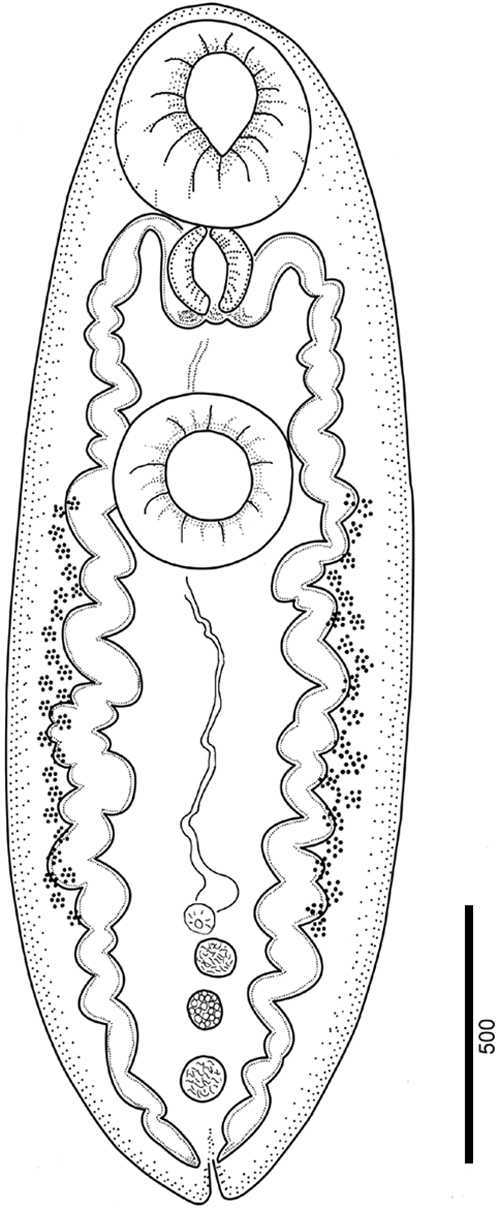The family Brachylaimidae Joyeux and Foley, 1930 (Trematoda) comprises 14 genera, including Brachylaima Dujardin, 1843 (the type genus). The genus Brachylaima contains 72 species that parasitize mammals and birds as definitive hosts around the word, except Antarctica (Butcher, 2003; Gracenea & González-Moreno, 2002; Lunaschi & Drago, 2012; Yamaguti, 1975). Terrestrial snails and slugs are involved as first and second intermediate hosts (Barger, 2011; Butcher, 2003; Butcher, Parasuramar, Thompson, & Grove, 1998; Cribb, 1990). The specificity at the level of the definitive host greatly differs in the Brachylaimidae (Guisantes, Benito, Estibalez, & Mas-Coma, 1994). Some species of the genus Brachylaima show an extensive range of potential definitive hosts, and experimental infections have demonstrated that the same species are able to infect and successfully develop in different species of mammals and birds (Timon-David, 1959). Several cases of human infections by adults of Brachylaima sp. causing consistent gastro-intestinal symptoms have been reported in Australia (Butcher & Groove, 2001; Butcher, Talbot, Norton, Kirk, Cribb, & Forsyth, 1996; Butcher et al., 1998; Butcher, Brealey, Grove, & Dymock, 2002). Infections can occur after eating raw mollusks containing metacercariae (Butcher, 2003).
During recent investigations focused on the role of terrestrial mollusks as intermediate hosts of parasites of public health importance in Argentina, terrestrial mollusks were collected (with permission of the Ministerio de Ecología y Recursos Naturales Renovables de la Provincia de Misiones) in twilight hours from Puerto Iguazú (Misiones, Argentina; 25°36′39″ S, 54°34′49″ W) during spring and summer of 2013 and 2014. Ninety-five specimens of Phyllocaulis variegatus Semper 1885 (Mollusca: Veronicellidae) were collected. The slugs were relaxed using menthol crystals dissolved in distilled water and kept in a refrigerator for up to 48 h (Cuezzo, 2013), then preserved in 70% ethanol and examined for parasites under a stereo microscope.
Thirteen of the 95 P. variegatus examined were parasitized by trematodes, recovering 235 metacercariae from the body cavity near the female genital pore. Parasites were stained with acetic carmine, dehydrated through ascending ethanol series, cleared with methyl salicylate, and mounted in Canada balsam. Drawings and measurements (range following by mean, in micrometers) were obtained with the aid of a light microscope Olympus BX51 with a camera lucida, and photographs were taken with an Olympus DP 71 camera. Identification of parasites was achieved following keys and specific bibliography (e.g., Butcher, 2003; Gibson, Jones, & Bray, 2001; Yamaguti, 1975). Voucher specimens of parasites were deposited in the Helminthological Collection of the Museo de la Plata, Argentina under the catalog number MLP He 6914.
Description based on 10 specimens of Brachylaima sp. (Figs. 1 and 2). Body elongate, 1670-2280 (1976) long, 480-750 (639) wide. Forebody 520-770 (653) long. Oral sucker 300-400 (360) long, 270-380 (335) wide. Ventral sucker 250-350 (291) long, 230-350 (279) wide. Inter-sucker distance 140-350 (262). Pharynx muscular, well developed, 140-180 (155) long, 140-170 (150) wide; sinuous caeca extending almost to the posterior margin of body. Anterior testis 65-100 (76) long, 50-84 (66) wide; posterior testis 66-100 (83) long, 50-93 (67) wide. Ovary intertesticular 55-92 (72) long, 50-80 (64) wide.

Figure 1 Metacercariae of Brachylaima sp. from the body cavity of Phyllocaulis variegatus (ventral view). Measurements are given in micrometers (µm).

Figure 2 Metacercariae of Brachylaima sp. from the body cavity of Phyllocaulis variegatus (ventral view). Measurements are given in micrometers (µm).
Although the specimens were immature, the following morphological characteristics allowed us to assign them to the genus Brachylaima: ventral sucker located in the first third of the body; genital pore in the zone of the anterior margin of the anterior testis; gonads located in the posterior part of the body, close together and near the posterior extremity; vitelline glands extending from the anterior margin of the ventral sucker to the anterior zone of the first testis and not surpassing it; uterus extending up to the intestinal bifurcation and thus clearly exceeding the anterior margin of the ventral sucker.
Metacercariae were found near the female genital pore, in contrast to previous studies, which recorded the metacercariae in the pericardial sac (Thiengo & Amato, 1995), or kidney (Barger & Hnida, 2008).
This is the first report of metacercariae of Brachylaima sp. in Argentina. In contrast, different species of Brachylaima have been reported to use several species of mollusks as intermediate hosts in other regions, including snails of gastronomic interest such as Otala punctata, Helix aspersa, and Theba pisana. In Australia, Brachylaima cribbiCribb, 1990, a parasite of T. pisana, was reported to cause human infections (Butcher, 2003; Gracenea & González-Moreno, 2002).
There are a number of previous records of adults of Brachylaima from birds and mammals in Argentina (Lunaschi & Drago, 2012; Martínez, 1986). Brachylaima migrans Dujardin, 1845 was found in the white-eared opossum Didelphis albiventris (Mammalia: Marsupialia) in Corrientes, Chaco, and Formosa Provinces. This mammal has frugivorous-omnivorous habits, although invertebrates (e.g., snails, slugs, worms, and arthropods) constitute an important part of its diet, it has been speculated that snails are involved as intermediate hosts (Santa Cruz, 2006). Particularly in Misiones Province, adult trematodes of the genus Brachylaima were observed parasitizing the gut of Didelphis aurita (Mammalia: Marsupialia) (GN, pers. comm.). Future experimental or molecular studies may corroborate the identity of the specimens reported here and elucidate their life cycle.
The authors wish to thank Rodrigo Santin for his assistance in the fieldwork, and Kabe Solas and Luis Giambelluca (CEPAVE) for their help with the drawings and photographs, respectively. We specially thank John Mike Kinsella for the English revision of the manuscript. This work was partially supported by UNLPN628 and UNLP N751.











 nueva página del texto (beta)
nueva página del texto (beta)


